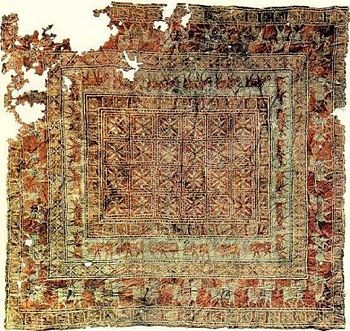Pazyryk Carpet: Difference between revisions
Jump to navigation
Jump to search

imported>Jim Bennight No edit summary |
mNo edit summary |
||
| (3 intermediate revisions by 3 users not shown) | |||
| Line 1: | Line 1: | ||
The Pazyryk | {{subpages}} | ||
The '''Pazyryk Carpet''' is the earliest surviving pile carpet in the world. Dating from the 5th-4th century BC, it was excavated by [[Sergei Ivanovich Rudenko]] in 1949 from a Siberian burial ground where it had been preserved in perma frost in the Pazyryk valley of the Altai Mountains in Siberian Russia south of the modern city of Novosibirsk. | |||
The origin of this carpet is attributed to either the Iranian Scythians or the Persian Achaemenids. This carpet is 6'6" x 6' (200 x 183 cm) and has approximately 360,000 knots/m². | The origin of this carpet is attributed to either the Iranian Scythians or the Persian Achaemenids. This carpet is 6'6" x 6' (200 x 183 cm) and has approximately 360,000 knots/m². | ||
| Line 5: | Line 6: | ||
Today the rug is in the Hermitage Museum in St. Petersburg, Russia. | Today the rug is in the Hermitage Museum in St. Petersburg, Russia. | ||
{{Image|Pazyrykcarpet.jpg|left|350px|The Pazyryk carpet.}}[[Category:Suggestion Bot Tag]] | |||
[[Category: | |||
Latest revision as of 06:01, 2 October 2024
The Pazyryk Carpet is the earliest surviving pile carpet in the world. Dating from the 5th-4th century BC, it was excavated by Sergei Ivanovich Rudenko in 1949 from a Siberian burial ground where it had been preserved in perma frost in the Pazyryk valley of the Altai Mountains in Siberian Russia south of the modern city of Novosibirsk.
The origin of this carpet is attributed to either the Iranian Scythians or the Persian Achaemenids. This carpet is 6'6" x 6' (200 x 183 cm) and has approximately 360,000 knots/m².
Today the rug is in the Hermitage Museum in St. Petersburg, Russia.
